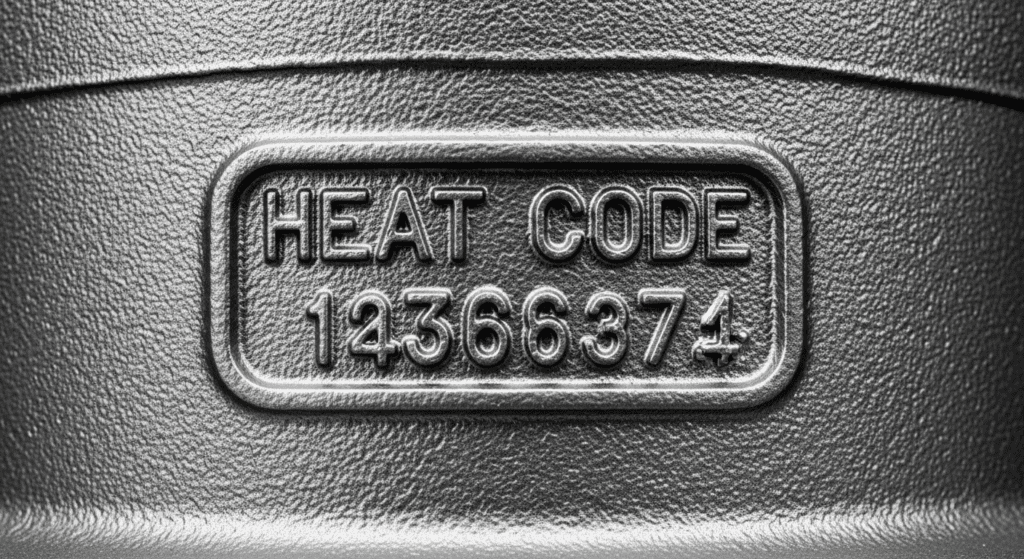The heat code in casting is a unique identification number assigned to a batch of metal during production. It links the casting to its chemical composition, manufacturing records, and quality certifications. Found on the product or documentation, it ensures traceability for safety, compliance, and quality control.

A heat code is a unique identification number assigned to each batch of molten metal produced in a foundry. This code acts like a birth certificate for metal castings, tracking the exact batch of material used to create specific parts.
When foundries melt metal, they produce it in large batches called “heats.” Each heat typically ranges from 1,000 to 100,000 pounds of molten metal, depending on the furnace size. The foundry assigns a unique code to each heat before pouring it into molds.
Heat codes serve three main purposes.
You’ll find heat codes stamped, etched, or cast directly onto metal parts. They appear on everything from small valve components to massive turbine housings. Without these codes, manufacturers couldn’t verify the quality or origin of their metal parts.
Each foundry uses its own coding system, but most follow similar patterns that reveal when and where the metal was produced.
The location of the heat code matters too. Manufacturers typically place codes on non-critical surfaces where they won’t interfere with the part’s function. Common locations include flanges, mounting surfaces, or designated flat areas on castings.
Numeric heat codes use only numbers to identify each batch of metal. A typical numeric code might look like “230145” or “2024-0892.”
The first digits often represent the year of production. For example, “23” indicates 2023. The remaining numbers show the sequential heat number for that year. So “230145” means the 145th heat produced in 2023.
Some foundries add more detail to their numeric codes. A code like “2024-0892-03” includes the year (2024), heat number (0892), and furnace number (03). This extra digit helps large facilities with multiple furnaces track production more precisely.
Alphanumeric codes combine letters and numbers to pack more information into the heat code. These codes might look like “A23B145” or “TF2024-M0892.”
Letters often indicate specific information about the casting process. “A” might represent the alloy type, while “B” could identify the furnace or production line. Some foundries use letters to show the month of production, with “A” for January through “L” for December.
For example, the code “SS316L-D24-0145” tells you several things at once. “SS316L” identifies the material as 316L stainless steel. “D” represents April (the fourth month). “24” shows the year 2024. “0145” is the sequential heat number.
Real heat code plates contain more than just the heat code itself. A typical plate might show “HEAT: A23B145” along with other markings like material grade, pressure ratings, or certification stamps.
Look for these common elements on a heat code plate. The heat code appears prominently, often after the word “HEAT” or “H/C.” You’ll see the material specification nearby, such as “A216 WCB” for carbon steel or “A351 CF8M” for stainless steel. The manufacturer’s name or logo usually appears somewhere on the plate.
Some plates include additional codes for material test reports. These might show “MTR: 2024-0145” or similar numbering that links to detailed chemical and mechanical test results.
Learn more about How to Read Heat Number
Different industries require specific heat code practices to ensure safety and quality. These requirements come from various organizations and vary by application.
ASME (American Society of Mechanical Engineers) sets heat code requirements for pressure vessels and piping components. ASME Section II mandates that all pressure-containing materials have traceable heat codes. Manufacturers must maintain records linking heat codes to chemical and mechanical test results for at least 5 years.
ASTM (American Society for Testing and Materials) provides detailed marking standards for different materials. ASTM A995 for duplex stainless steel castings requires heat numbers on each casting. ASTM A216 for carbon steel castings specifies that marks must remain legible throughout the part’s service life.
European standards use the EN (European Norm) system for heat code requirements. EN 10204 defines four types of inspection certificates, from basic compliance declarations to detailed third-party verified reports. Each certificate type requires different levels of heat code documentation.
ISO 9001 quality standards require documented procedures for heat code assignment and tracking. Companies must show how they maintain traceability from raw materials through finished products. This includes recording heat codes at each manufacturing step.
API (American Petroleum Institute) standards add industry-specific requirements. API 6D for pipeline valves requires heat codes on all pressure-containing parts. API 598 mandates that replacement parts carry the same level of heat code identification as original components.
